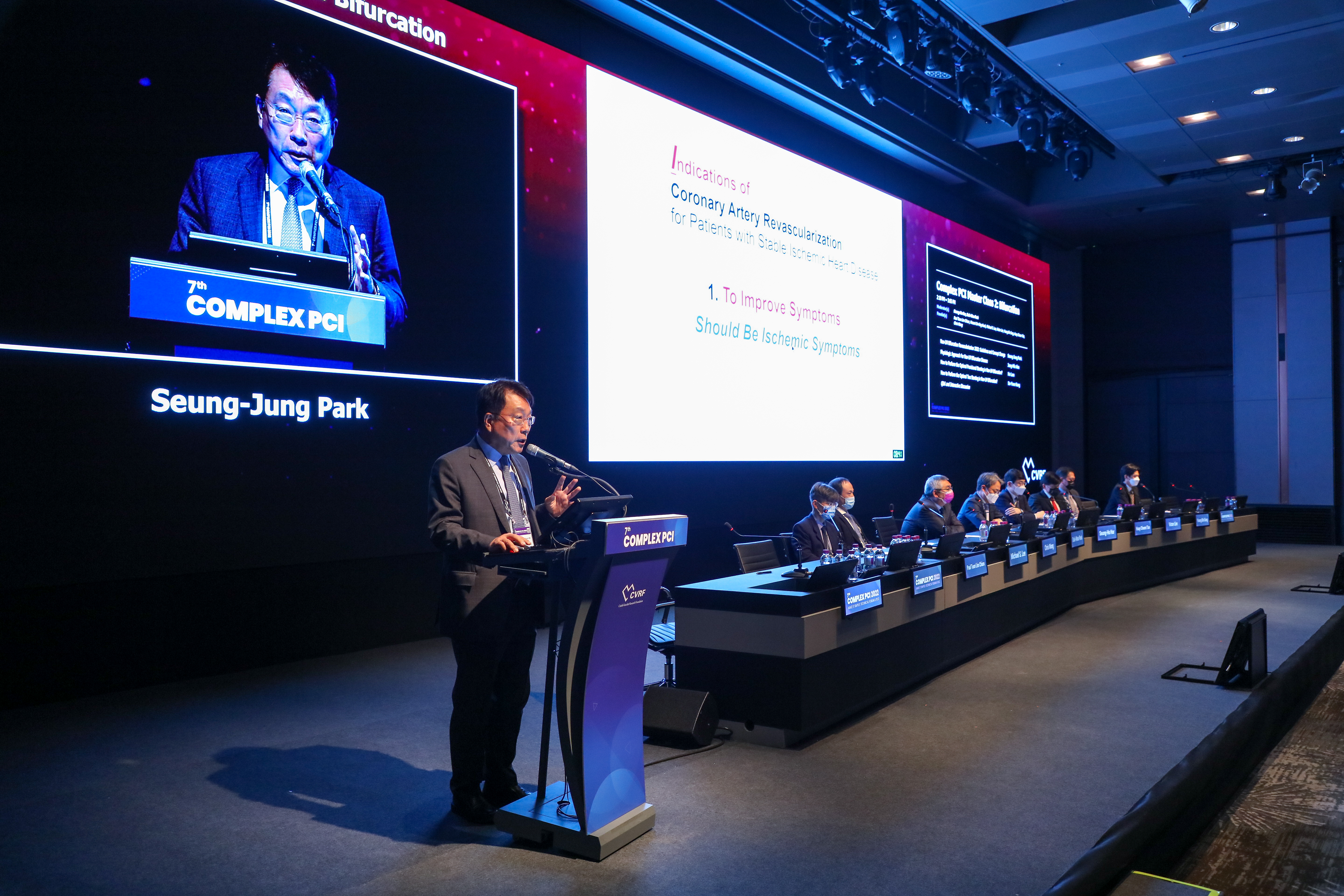News | COMPLEX PCI 2022
[COMPLEX PCI] Guideline and concept changes: revascularization for non-LM bifurcations in 2022
Cutting down unnecessary revascularizations key for non-left main bifurcation PCIs as GDMT suffices for most SIHD patients
 Rolling back unnecessary revascularizations for non-left main (LM) bifurcation lesions is a priority to improve outcomes, an expert said, since optimized medical therapy is “good enough” for most patients with stable ischemic heart disease (SIHD).
Rolling back unnecessary revascularizations for non-left main (LM) bifurcation lesions is a priority to improve outcomes, an expert said, since optimized medical therapy is “good enough” for most patients with stable ischemic heart disease (SIHD).
“Clinical outcomes of percutaneous coronary intervention (PCI) for non-LM bifurcation lesions are clearly related to the status of the main branch (MB),” Seung-Jung Park, MD, PhD(Asan Medical Center, Seoul, South Korea) said on Nov 24 at COMPLEX PCI, which ran for two days at the Grand Walkerhill Seoul in South Korea. “The major concept is avoiding the side branch (SB) if small – before or after the procedure – which pertains to about 80% of non-LM bifurcations.”

Seung-Jung Park, MD, PhD presents major guideline and concept changes for revascularization in non-LM bifurcation lesions at COMPLEX PCI at the Grand Walkerhill Seoul in South Korea on Nov 24.
Emphasis on less is more in non-LM bifurcation PCIs stems partly from the ISCHEMIA study – deemed as the “most impactful trial since COURAGE” – and the ISCHEMIA-EXTEND follow-up study that reported no significant difference between guideline-directed medical therapy (GDMT)-based conservative care (n=2,591) and invasive revascularization with either coronary artery bypass surgery (CABG) or PCI (n=2,588) in patients with stable coronary disease and moderate or severe ischemia.
The simple rule is to treat – if and only if – there are ischemic symptoms and treat large SBs (>2.5 mm).
At median follow-up of 3.2 years, ISCHEMIA found no survival or ischemic benefits (composite of CVD death, MI or hospitalization for unstable angina, HF, or resuscitated cardiac arrest) with initial invasive revascularization over conservative care (invasive-strategy group 5.3% vs. conservative-strategy group 3.4%; difference 1.9%p; 95% CI; 0.8-3.0).
At 5 years, rates for cumulative events (invasive group 16.4% vs. conservative 18.2%; difference −1.8%p; -4.7-1.0), all-cause mortality (invasive 9.0% vs. conservative 8.3%; difference 0.7; -1.6-3.1) and MI (10.3% vs. 11.9%; difference -1.6; -3.9-0.7) were statistically non-significant.
ISCHEMIA-EXTEND (median follow-up 5.7 years) relayed the same message, reporting no significant difference for the all-cause mortality outcome at 7-years between the initial invasive strategy and conservative strategy groups (12.7% vs. 13.4%; aHR 1.00; 95% CI; 0.85-1.18).
The findings were pertinent as coronary computed tomography angiography (CCTA) assessment showed more than 75% of the ISCHEMIA population had multivessel disease (MVD) and stenosis over 50%, Park said: “GDMT was good enough for the majority of SIHD patients, so the focus is on reducing unnecessary revascularizations, especially for PCI.”
Individualizing treatment strategies according coronary artery disease (CAD) severity based on “ISCHEMIA criteria,” he added, is also an important consideration to reduce excess revascularizations.
Analysis of ISCHEMIA findings stratified by CAD and ischemia severity showed revascularization with either PCI or CABG and GDMT was reasonable for high-risk patients with significant stenosis (≥70%) in 3 vessels (3VD); any revascularization with GDMT was suitable for high-risk patients with significant stenosis (≥70%) in 2 vessels (2VD) and the proximal left anterior descending (LAD) artery; medical therapy alone was sufficient for intermediate-risk (2VD >70%; 3VD>50%; or >70% pLAD) and low-risk patients (1VD with >70% stenosis; 3VD >50%; or any 1VD >50%).
“Although studies have shown better outcomes with revascularization for patients with large ischemic burden – when fractional myocardial mass (FMM) is greater than 10% – analysis shows non-LM bifurcation PCIs do not improve survival for patients with large ischemic burden in real-world practice because the supplied myocardial mass is often too small, only a minority of stable PCI patients meet ISCHEMIA criteria, and small SBs have small ischemic burden.”
Without symptoms, leave the small side branch (<2.5 mm) and all jailed SBs alone. Medical therapy is enough.
Park noted that South Korean investigators previously reported only 20% of large SBs (>2.5 mm) had FMM greater than 10% (roughly “1.2-vessel disease”), which paled in comparison to the high FMM rates found in LM and 2-vessel disease.
Upfront 2-stenting vs provisional stenting
When deciding between upfront 2-stenting and provisional stenting, the main vessel (MV) status and SB size are crucial considerations, Park said.
“Upfront 2-stenting, with either Double-Kissing (DK) Crush or Culotte techniques, is better than provisional stenting for all complex bifurcations with large SB (>2.5 mm),” he said. “Small SBs (<2.5 mm), especially jailed SBs, should be left alone without the presence of symptoms.”
“Do not treat the jailed SB if there are no symptoms,” he added. “No chest pain means no survival benefit so there’s no rationale to pursue more treatment for asymptomatic jailed SBs.”
Along with no survival benefit, previous studies showed that more than 70% of fractional flow reserve (FFR) measurements of jailed SBs were negative (FFR ≤0.80) and aggressive treatment paradoxically increased the risk of target-vessel failure (TVF).
Major guidelines also backed the use of GDMT over revascularization in SIHD patients. The 2021 American College of Cardiology and American Heart Association (ACC/AHA) guidelines recommended invasive revascularization only to improve symptoms or survival. Symptoms, which can be “very subjective” from the physician’s point of view, should be ischemic, Park said.
To improve survival, the 2021 ACC/AHA guidelines strongly recommended CABG for LM disease (Class 1) but gave a weaker Class 2a recommendation for CABG in MVD with <50% ejection fraction (EF). American guidance also gave a weaker recommendation (Class 2b) for any revascularization in MVD patients with EF> 50%. For 3VD patients with diabetes, CABG was strongly recommended (Class 1); PCI could be considered if patients were poor candidates for CABG (Class 2a).
“Understanding the concept is more important than techniques for non-LM bifurcation lesions,” Park said. “The simple rule? Treat – if and only if – there are ischemic symptoms and treat large SBs (>2.5 mm) with the upfront 2-stent technique (<20%). Without symptoms, leave small SBs (<2.5 mm) and all jailed SBs – no matter the size – alone. Medical therapy is enough.”
Edited by

Jung-Min Ahn , MD
Asan Medical Center, Korea (Republic of)
Written by

YoonJee Marian Chu, Medical Journalist
Read Biography
 Rolling back unnecessary revascularizations for non-left main (LM) bifurcation lesions is a priority to improve outcomes, an expert said, since optimized medical therapy is “good enough” for most patients with stable ischemic heart disease (SIHD).
Rolling back unnecessary revascularizations for non-left main (LM) bifurcation lesions is a priority to improve outcomes, an expert said, since optimized medical therapy is “good enough” for most patients with stable ischemic heart disease (SIHD).
“Clinical outcomes of percutaneous coronary intervention (PCI) for non-LM bifurcation lesions are clearly related to the status of the main branch (MB),” Seung-Jung Park, MD, PhD(Asan Medical Center, Seoul, South Korea) said on Nov 24 at COMPLEX PCI, which ran for two days at the Grand Walkerhill Seoul in South Korea. “The major concept is avoiding the side branch (SB) if small – before or after the procedure – which pertains to about 80% of non-LM bifurcations.”

Seung-Jung Park, MD, PhD presents major guideline and concept changes for revascularization in non-LM bifurcation lesions at COMPLEX PCI at the Grand Walkerhill Seoul in South Korea on Nov 24.
Emphasis on less is more in non-LM bifurcation PCIs stems partly from the ISCHEMIA study – deemed as the “most impactful trial since COURAGE” – and the ISCHEMIA-EXTEND follow-up study that reported no significant difference between guideline-directed medical therapy (GDMT)-based conservative care (n=2,591) and invasive revascularization with either coronary artery bypass surgery (CABG) or PCI (n=2,588) in patients with stable coronary disease and moderate or severe ischemia.
The simple rule is to treat – if and only if – there are ischemic symptoms and treat large SBs (>2.5 mm).
At median follow-up of 3.2 years, ISCHEMIA found no survival or ischemic benefits (composite of CVD death, MI or hospitalization for unstable angina, HF, or resuscitated cardiac arrest) with initial invasive revascularization over conservative care (invasive-strategy group 5.3% vs. conservative-strategy group 3.4%; difference 1.9%p; 95% CI; 0.8-3.0).
At 5 years, rates for cumulative events (invasive group 16.4% vs. conservative 18.2%; difference −1.8%p; -4.7-1.0), all-cause mortality (invasive 9.0% vs. conservative 8.3%; difference 0.7; -1.6-3.1) and MI (10.3% vs. 11.9%; difference -1.6; -3.9-0.7) were statistically non-significant.
ISCHEMIA-EXTEND (median follow-up 5.7 years) relayed the same message, reporting no significant difference for the all-cause mortality outcome at 7-years between the initial invasive strategy and conservative strategy groups (12.7% vs. 13.4%; aHR 1.00; 95% CI; 0.85-1.18).
The findings were pertinent as coronary computed tomography angiography (CCTA) assessment showed more than 75% of the ISCHEMIA population had multivessel disease (MVD) and stenosis over 50%, Park said: “GDMT was good enough for the majority of SIHD patients, so the focus is on reducing unnecessary revascularizations, especially for PCI.”
Individualizing treatment strategies according coronary artery disease (CAD) severity based on “ISCHEMIA criteria,” he added, is also an important consideration to reduce excess revascularizations.
Analysis of ISCHEMIA findings stratified by CAD and ischemia severity showed revascularization with either PCI or CABG and GDMT was reasonable for high-risk patients with significant stenosis (≥70%) in 3 vessels (3VD); any revascularization with GDMT was suitable for high-risk patients with significant stenosis (≥70%) in 2 vessels (2VD) and the proximal left anterior descending (LAD) artery; medical therapy alone was sufficient for intermediate-risk (2VD >70%; 3VD>50%; or >70% pLAD) and low-risk patients (1VD with >70% stenosis; 3VD >50%; or any 1VD >50%).
“Although studies have shown better outcomes with revascularization for patients with large ischemic burden – when fractional myocardial mass (FMM) is greater than 10% – analysis shows non-LM bifurcation PCIs do not improve survival for patients with large ischemic burden in real-world practice because the supplied myocardial mass is often too small, only a minority of stable PCI patients meet ISCHEMIA criteria, and small SBs have small ischemic burden.”
Without symptoms, leave the small side branch (<2.5 mm) and all jailed SBs alone. Medical therapy is enough.
Park noted that South Korean investigators previously reported only 20% of large SBs (>2.5 mm) had FMM greater than 10% (roughly “1.2-vessel disease”), which paled in comparison to the high FMM rates found in LM and 2-vessel disease.
Upfront 2-stenting vs provisional stenting
When deciding between upfront 2-stenting and provisional stenting, the main vessel (MV) status and SB size are crucial considerations, Park said.
“Upfront 2-stenting, with either Double-Kissing (DK) Crush or Culotte techniques, is better than provisional stenting for all complex bifurcations with large SB (>2.5 mm),” he said. “Small SBs (<2.5 mm), especially jailed SBs, should be left alone without the presence of symptoms.”
“Do not treat the jailed SB if there are no symptoms,” he added. “No chest pain means no survival benefit so there’s no rationale to pursue more treatment for asymptomatic jailed SBs.”
Along with no survival benefit, previous studies showed that more than 70% of fractional flow reserve (FFR) measurements of jailed SBs were negative (FFR ≤0.80) and aggressive treatment paradoxically increased the risk of target-vessel failure (TVF).
Major guidelines also backed the use of GDMT over revascularization in SIHD patients. The 2021 American College of Cardiology and American Heart Association (ACC/AHA) guidelines recommended invasive revascularization only to improve symptoms or survival. Symptoms, which can be “very subjective” from the physician’s point of view, should be ischemic, Park said.
To improve survival, the 2021 ACC/AHA guidelines strongly recommended CABG for LM disease (Class 1) but gave a weaker Class 2a recommendation for CABG in MVD with <50% ejection fraction (EF). American guidance also gave a weaker recommendation (Class 2b) for any revascularization in MVD patients with EF> 50%. For 3VD patients with diabetes, CABG was strongly recommended (Class 1); PCI could be considered if patients were poor candidates for CABG (Class 2a).
“Understanding the concept is more important than techniques for non-LM bifurcation lesions,” Park said. “The simple rule? Treat – if and only if – there are ischemic symptoms and treat large SBs (>2.5 mm) with the upfront 2-stent technique (<20%). Without symptoms, leave small SBs (<2.5 mm) and all jailed SBs – no matter the size – alone. Medical therapy is enough.”
Edited by

Jung-Min Ahn , MD
Asan Medical Center, Korea (Republic of)
Written by


Leave a comment